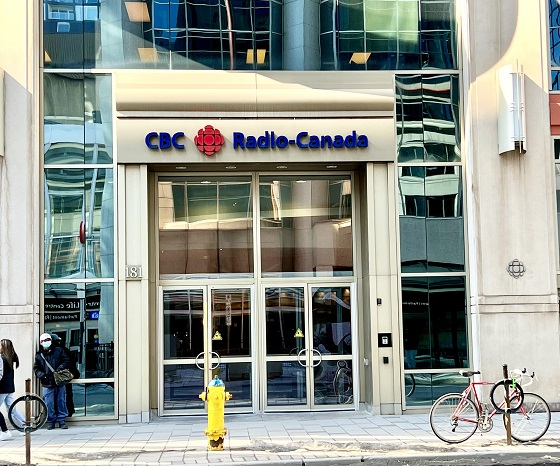Business
Even CBC’s friends are big mad about the big bonuses

From the Canadian Taxpayers Federation
Author: Kris Sims
This even weirder than the Masters of the Universe cartoon episode where the hero He-Man teamed up with the villain Skeletor to save Christmas.
The CBC doled out $18.4 million in bonuses. Meanwhile, the state broadcaster was also threatening to eliminate some positions just before Christmas. And that has even its “friends” upset.
A group called Friends of Canadian Media typically functions as a cheerleading squad for the CBC.
The group has praised the state broadcaster for years, comparing people who want it defunded to fans of professional wrestling – as if that’s a grave insult.
But this latest plot twist from the CBC even has its friends delivering a smack down.
In an email to supporters about the CBC bonuses, Friends of Canadian Media stated:
“This decision is deeply out of touch and unbefitting of our national public broadcaster.”
When it comes to these big bonuses, the CBC’s cheer team is now agreeing with the Canadian Taxpayers Federation that the bonuses are wrong.
Now, that’s where the agreement ends.
“CBC/Radio-Canada’s per capita funding currently sits at a 60-year low, thanks to decades of neglect from successive governments of all political stripes,” the group writes.
The CBC has “low funding” and is suffering from “neglect”?
The friends might want to lay off the kale smoothies for a bit because it sounds like they’re going fermented and that’s clouding their judgement.
The CBC’s government funding is astronomical and it gets an obscene amount of attention from our government, despite its ratings circling the drain.
The CBC’s taking $1.4 billion from taxpayers this year.
The money we spend on the CBC could pay the salaries of about 7,000 cops and 7,000 paramedics. It could buy more than 3,000 homes in Alberta. It would cover groceries for about 85,000 Canadian families for a year.
What the CBC costs taxpayers is the opposite of low funding.
The CBC has dished out $130 million in bonuses since 2015. There are 1,450 CBC staffers taking home six-figure salaries. Since 2015, the number of CBC employees taking a six-figure salary has soared by 231 per cent.
The Canadian Press reported that latest round of bonuses for executives at the CBC is more than $70,000 per person. That’s more than the average Canadian family takes home in a year.
The CEO of the CBC, Catherine Tait, is paid between $460,900 and $551,600 in salary per year. She’s also entitled to a bonus of up to 28 per cent. For the kids paying attention in math class, that’s a potential bonus of up to $154,448.
That’s a super weird form of low funding and neglect.
It’s got to be tough to land that woe-is-me message when millions get thrown around for bonuses.
Even a CBC news anchor asked her boss tough questions about the bonuses on national television.
“The Canadian Taxpayers Federation, through an FOI request, showed $16 million were paid in bonuses in 2022, can we establish that is not happening this year?” Adrienne Arsenault asked Tait on Dec. 4, 2023.
“I am not going to comment on something that hasn’t been discussed at this point,” Tait replied.
Turns out: those bonuses were in the works and now we know they’re costing taxpayers $18.4 million this year.
Meanwhile, Canadians are tuning out of the CBC while being forced to pay for it.
The CBC News Network’s share of the national prime-time viewing audience is 2.1 per cent, according to its latest third-quarter report.
Put another way, 97.9 per cent of TV-viewing Canadians choose not to watch CBC’s English language prime-time news program.
The CBC needs to be defunded. It’s a huge waste of money, a tiny handful of Canadians are tuning in and journalists should not be paid by the government. It’s a good bet the debate on that larger point will keep getting hotter.
But this part of the debate is down for the count: the outrageous CBC bonuses need to end.
When the Canadian Taxpayers Federation and Friends of Canadian Media agree on something, consensus has been achieved and the fight’s over.
Kris Sims is the Alberta Director for the Canadian Taxpayers Federation and a former member of the Parliamentary Press Gallery.
Business
Rhetoric—not evidence—continues to dominate climate debate and policy

From the Fraser Institute
Myths, fallacies and ideological rhetoric continue to dominate the climate policy discussion, leading to costly and ineffective government policies,
according to a new study published today by the Fraser Institute, an independent, nonpartisan Canadian public policy think-tank.
“When considering climate policies, it’s important to understand what the science and analysis actually show instead of what the climate alarmists believe to be true,” said Kenneth P. Green, Fraser Institute senior fellow and author of Four Climate Fallacies.
The study dispels several myths about climate change and popular—but ineffective—emission reduction policies, specifically:
• Capitalism causes climate change: In fact, according to several environment/climate indices and the Fraser Institute’s annual Economic Freedom of the World Index, the more economically free a country is, the more effective it is at protecting its environment and combatting climate change.
• Even small-emitting countries can do their part to fight climate change: Even if Canada reduced its greenhouse gas emissions to zero, there would be
little to no measurable impact in global emissions, and it distracts people from the main drivers of emissions, which are China, India and the developing
world.
• Vehicle electrification will reduce climate risk and clean the air: Research has shown that while EVs can reduce GHG emissions when powered with
low-GHG energy, they often are not, and further, have offsetting environmental harms, reducing net environmental/climate benefits.
• Carbon capture and storage is a viable strategy to combat climate change: While effective at a small scale, the benefits of carbon capture and
storage to reduce global greenhouse gas emissions on a massive scale are limited and questionable.
“Citizens and their governments around the world need to be guided by scientific evidence when it comes to what climate policies make the most sense,” Green said.
“Unfortunately, the climate policy debate is too often dominated by myths, fallacies and false claims by activists and alarmists, with costly and ineffective results.”

Kenneth P. Green
Senior Fellow, Fraser Institute
Business
Canada’s economic pain could be a blessing in disguise

This article supplied by Troy Media.
 By Roslyn Kunin
By Roslyn Kunin
Tariffs, inflation, and falling incomes sound bad, but what if they’re forcing us to finally fix what’s broken?
Canada is facing serious economic headwinds—from falling incomes to rising inflation and U.S. trade hostility—but within this turmoil lies an opportunity. If we respond wisely, this crisis could become a turning point, forcing long-overdue reforms and helping us build a stronger, more independent economy.
Rather than reacting out of frustration, we can use these challenges to reassess what’s holding us back and move forward with practical solutions. From
trade policy to labour shortages and energy development, there are encouraging shifts already underway if we stay focused.
A key principle when under pressure is not to make things worse for ourselves. U.S. tariffs on Canadian steel and aluminum, and the chaotic renegotiation of NAFTA/CUSMA, certainly hurt our trade-dependent economy. But retaliatory tariffs don’t work in our favour. Canadian imports make
up a tiny fraction of the U.S. economy, so countermeasures barely register there, while Canadian consumers end up paying more. The federal government’s own countertariffs on items like orange juice and whisky raised costs here without changing American policy.
Fortunately, more Canadians are starting to realize this. Some provinces have reversed bans on U.S. goods. Saskatchewan, for example, recently lifted
restrictions on American alcohol. These decisions reflect a growing recognition that retaliating out of pride often means punishing ourselves.
More constructively, Canada is finally doing what should have happened long ago: diversifying trade. We’ve put too many economic eggs in one
basket, relying on an unpredictable U.S. market. Now, governments and businesses are looking for buyers elsewhere, an essential step toward greater stability.
At the same time, we’re starting to confront domestic barriers that have held us back. For years, it’s been easier for Canadian businesses to trade with the U.S. than to ship goods across provincial borders. These outdated restrictions—whether on wine, trucks or energy—have fractured our internal market. Now, federal and provincial governments are finally taking steps to create a unified national economy.
Labour shortages are another constraint limiting growth. Many Canadian businesses can’t find the skilled workers they need. But here, too, global shifts
are opening doors. The U.S.’s harsh immigration and research policies are pushing talent elsewhere, and Canada is emerging as the preferred alternative.
Scientists, engineers and graduate students, especially in tech and clean energy, are increasingly choosing Canada over the U.S. due to visa uncertainty and political instability. Our universities are already benefiting. If we continue to welcome international students and skilled professionals, we’ll gain a long-term advantage.
Just as global talent is rethinking where to invest their future, Canada has a chance to reassert leadership in one of its foundational industries: energy.
The federal government is now adopting a more balanced climate policy, shifting away from blanket opposition to carbon-based energy and focusing instead on practical innovation. Technologies such as carbon capture and storage are reducing emissions and helping clean up so-called dirty oil. These cleaner energy products are in demand globally.
To seize that opportunity, we need infrastructure: pipelines, refining capacity and delivery systems to get Canadian energy to world markets and across our own country. Projects like the Trans Mountain pipeline expansion, along with east-west grid connections and expanded refining, are critical to reducing dependence on U.S. imports and unlocking Canada’s full potential.
Perhaps the most crucial silver lining of all is a renewed awareness of the value of this country. As we approach July 1, more Canadians are recognizing how fortunate we are. Watching the fragility of democracy in the U.S., and confronting the uncomfortable idea of being reduced to a 51st state, has reminded us that Canada matters. Not just to us, but to the world.
Dr. Roslyn Kunin is a respected Canadian economist known for her extensive work in economic forecasting, public policy, and labour market analysis. She has held various prominent roles, including serving as the regional director for the federal government’s Department of Employment and Immigration in British Columbia and Yukon and as an adjunct professor at the University of British Columbia. Dr. Kunin is also recognized for her contributions to economic development, particularly in Western Canada.
Troy Media empowers Canadian community news outlets by providing independent, insightful analysis and commentary. Our mission is to support local media in helping Canadians stay informed and engaged by delivering reliable content that strengthens community connections and deepens understanding across the country.
-

 Alberta1 day ago
Alberta1 day agoAlberta health care blockbuster: Province eliminating AHS Health Zones in favour of local decision-making!
-

 Crime2 days ago
Crime2 days agoUK finally admits clear evidence linking Pakistanis and child grooming gangs
-

 conflict1 day ago
conflict1 day agoTrump: ‘We’ have control over Iranian airspace; know where Khomeini is hiding
-

 Alberta16 hours ago
Alberta16 hours agoAlberta pro-life group says health officials admit many babies are left to die after failed abortions
-

 Alberta15 hours ago
Alberta15 hours agoCentral Alberta MP resigns to give Conservative leader Pierre Poilievre a chance to regain a seat in Parliament
-

 Business2 days ago
Business2 days agoCarney praises Trump’s world ‘leadership’ at G7 meeting in Canada
-

 Daily Caller16 hours ago
Daily Caller16 hours ago‘Not Held Hostage Anymore’: Economist Explains How America Benefits If Trump Gets Oil And Gas Expansion
-

 Business2 days ago
Business2 days agoTrump family announces Trump Mobile: Made in America, for America


